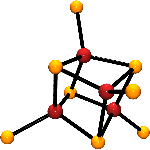The objectives of the synthetic analogue approach in bioinorganic chemistry originally were defined as (i) the "deduction of minimal site structure (where unknown) based on coincident model-biomolecule properties or (where known) required for execution of biological function," and (ii) "the detection of the influence of the biomolecular environment on the intrinsic properties of the site as represented by the model". As bioanalytical tools have advanced, metal cofactors of unprecedented complexity have been uncovered that raise, but do not answer, underlying chemical questions concerning structure and function, and lie beyond the scope of established inorganic synthetic schemes. Therein lies the third objective of the synthetic analogue approach: "the broad exploration of fundamental chemistry as motivated by a biological system, with the immediate goal establishing possibilities and methodologies that ultimately will lead to corroborative synthetic analogue, a chemical understanding of the inspirational system."
A case in point is the FeMo-cofactor of nitrogenase, where the revelation of a light interstitial atom X (X = C, N, O) in the trigonal prismatic Fe6 portion of the MoFe6S9X cluster core has necessitated reexamination of possible synthetic approaches to such a cluster. Towards this end, we have synthesized and characterized a new class of mid-valent, high nuclearity Fe-N clusters as an attempt to uncover synthetic methodologies and structure/electronic properties which may be relevant to the FeMo-cofactor.
cluster core has necessitated reexamination of possible synthetic approaches to such a cluster. Towards this end, we have synthesized and characterized a new class of mid-valent, high nuclearity Fe-N clusters as an attempt to uncover synthetic methodologies and structure/electronic properties which may be relevant to the FeMo-cofactor.
Copyright © 2024 The President and Fellows of Harvard College | Accessibility | Digital Accessibility | Report Copyright Infringement

